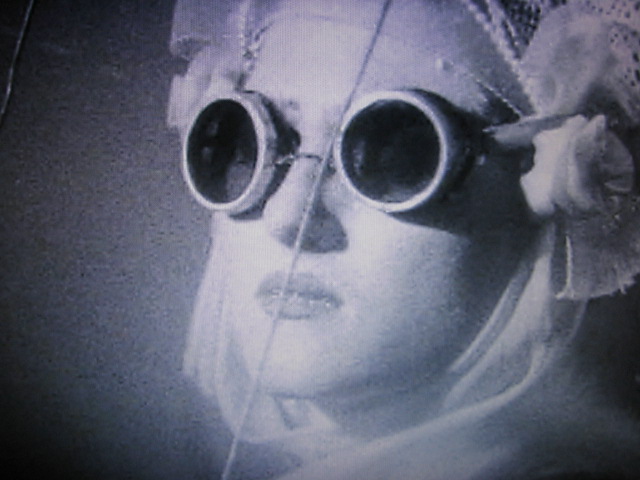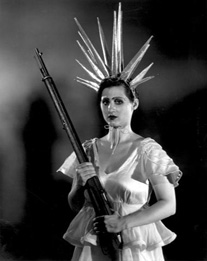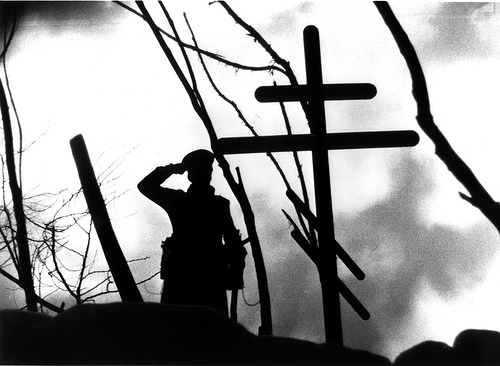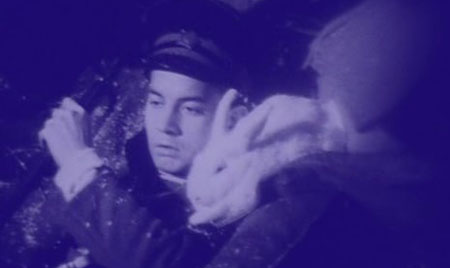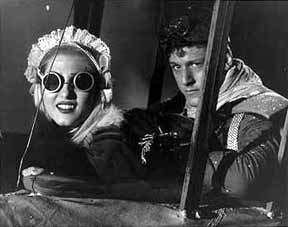From the Chicago Reader (March 1, 1991) — J.R.
ARCHANGEL
*** (A must-see)
Directed by Guy Maddin
Written by George Toles and Maddin
With Kyle McCulloch, Kathy Marykuca, Ari Cohen, Sarah Neville, Michael Gottli, and Victor Cowie.
Amnesia is a subject we associate with film noir of the 40s and 50s, and social commentators tend to link its use in such films — with their gloomy and murky moods, their amnesiac heroes’ helplessness — to some version of postwar angst. Now it appears that amnesia — both as subject and as metaphor — is making a minor comeback as a postmodernist theme. An early instance of this trend can be found in the fate of Tyrone Slothrop, the hero of Thomas Pynchon’s 1973 novel Gravity’s Rainbow, who gradually gets phased out of the book as a visible presence once he starts shifting his attention from his inscrutable, troubling past to his immediate present. We learn that “‘personal density is directly proportional to temporal bandwidth….Temporal bandwidth’ is the width of your present, your now … [and] the narrower your sense of Now, the more tenuous you are. It may even get to where you’re having trouble remembering what you were doing five minutes ago, or even — as Slothrop now — what you’re doing here, at the base of this colossal curved embankment…”
It’s a paradoxical hallmark of postmodernist art to be preoccupied with certain aspects of the past while being closed off — whether through indifference or ignorance or (real or metaphorical) amnesia — to certain other aspects. Gravity’s Rainbow, for instance, is both a well-researched historical novel set during World War II and a contemporary meditation on history couched in the language, idioms, and sensibility of the late 60s and early 70s. MTV, which offers a sort of Cook’s tour through the history of film style, is generally both attentive to the surface appearance of various styles and blind to their historical contexts and meanings. Similarly, when Woody Allen in Bananas (1971) or Brian De Palma in The Untouchables (1987) alludes to the Odessa steps/baby carriage sequence in Eisenstein’s Potemkin (1925), the effect is to remove Eisenstein’s baby carriage from its historical context. (The fact that Bananas is set in the present and The Untouchables is set in 1930 is irrelevant; both films occupy a “now” that’s almost as narrow as Slothrop’s.)
Archangel — the second feature of Guy Maddin, a Canadian independent based in Winnipeg whose Tales From the Gimli Hospital turned up here a year and a half ago — is set during World War I and the Russian Revolution. Filmed, like its predecessor, in dreamy, murky, and nostalgic black and white, with a quaintly dubbed and muffled sound track, it both looks and sounds like an arty studio picture from the late silent or early sound era. Yet the superimposition of a late 20s/early 30s style over a story set around 1917 yields a movie that is oddly ahistorical and that seems set adrift from any sustained sense of place, time, or even meaning. The film’s true subject, in fact — if it has one at all — is amnesia: virtually all the major characters suffer from it acutely, to such a degree that they can barely grasp their own identities — or anyone else’s, for that matter. And the film induces a kind of existential free-fall in the spectator that is oddly akin to the helplessness of the characters.
The fascinating thing about Archangel, playing at the Film Center this week, is that it hardly seems aware of its own identity, in spite of the fact that it is original and distinctive — even more so than the superficially similar (if funnier and gorier) Tales From the Gimli Hospital, which can more easily be palmed off as an arcane offshoot of David Lynch’s Eraserhead. Archangel isn’t consistently a comedy or a work of facetious camp or a serious drama, although it may occasionally come across as all three — sometimes all three at once. Theoretically, comedy and drama represent separate emotional registers, with camp occupying some ambiguous no-man’s-land between them. But the tone of Archangel is so private and hermetic that it allows the viewer equal access — or equal lack of access — to all these registers at any given moment. The result is that one can never remain firmly inside any one of these emotional attitudes but instead drifts, rather like the film itself — gliding over each of the emotional possibilities in a state of perpetual detachment and bemusement.
Consider the film’s eerie opening: light snowflakes fall past antique-looking credits while we hear a tolling bell and muffled rifle shots. Then two quaint intertitles appear: “For certain soldiers / lately dead / a reverent dirge / shall here be said” and “The Dirge of Lt. John Boles.” Cut to a close-up of Boles himself (Kyle McCulloch) under falling snowflakes; the camera pans down, first to the urn labeled “Iris” that he clutches with both hands beside a ship’s railing, then to his legs, one of which is wooden. “Good-bye, Iris,” we hear him say offscreen, shortly after he fingers her ashes inside the urn.
Boles looks to the right, where the captain stands with two women, taking various objects from them and tossing them overboard. A little later, the captain takes the urn from Boles and tosses that overboard, too. The men exchange stiff salutes, Boles exits, and a close-up shows the captain watching his departure.
Then, over organ music, the word “love” appears and grows larger on the black screen, while a male narrator delivers the following monologue with all the glum sincerity of the commentator in Edward D. Wood Jr.’s Glen or Glenda?: “Love — what do we know of love? We know a baby loves with all its tiny heart” — close-up of a baby in soft focus — “and is loved in return by hearts as simple and as pure. We know a growing child thrives on love” — several kitschy shots of doting parents, family members, and a toddler with a pet dog –“and with its generous limbs apportions that love to the rest of the world.”
As the monologue continues, brief shots continue to illustrate it on a point-by-point basis: “One is said to love a place, a thing, an idea” is given three shots, one each for the last three nouns; “You love your country and your liberty” is given two shots. “And of course, there is the greatest love of all — that of a gentle soul in thoughtful prayer” is accorded no less than seven separate shots of people praying. “Then there is pride or self-love — a malignant vanity, insatiable — the pride of the Teuton” ushers in a succession of images bursting into flames: soldiers ripping apart paintings, a little boy with an apple on his head killed by a firing squad, a corpse’s neck devoured by a savage warrior, demonic shadows, close-ups of grief-stricken victims, and, finally, multiple images of a single bestial soldier that circle the screen.
This passage on “love” may sound like a hoot, and some of it is certainly hilarious, but the overall style is too doggedly pictorial to register as a simple send-up. It’s almost as if Maddin set out to construct a piece of camp and then got lost in the images themselves, forgetting his initial project.
From any conventional standpoint, some of the film’s technique is slapdash. While Maddin is often adept at faking the look of late silents and early talkies — smearing the edges of the lens with Vaseline to get blurry and dreamlike effects, using various forms of superimposition, working with shadows and silhouettes, and even employing what appears to be rear-projection to get some moving scenery behind a carriage — the dubbing is variable (sometimes disembodied, occasionally out of sync), the editing is frequently abrupt and clunky, some of the special effects are grade-Z, and the story telling periodically becomes incoherent. Whether these flaws derive from some perverse master strategy — a desire to imitate the look and sound of battered, spliced prints of old movies–or whether they can be ascribed to technical inadequacies or indifference is impossible to determine. But it’s part of the film’s singularity that one may wind up questioning whether any of these distinctions matter very much.
Boles — a Canadian soldier in the Russian arctic, fighting on the side of the White Russians against Lenin’s Bolsheviks and Kaiser Wilhelm’s Huns — meets a Russian nurse named Veronkha (Kathy Marykuca) whom he confuses with the dead Iris. Veronkha has been married to a Belgian aviator named Philbin (Ari Cohen) whose memory appears to be even more impaired than Boles’s, and she claims she got the marriage annulled after she caught Philbin with a chambermaid on their wedding night and discovered that he couldn’t even remember that he was married. Eventually, Veronkha herself becomes so confused that she thinks Boles is actually Philbin. To make matters even murkier, Boles’s landlady, Danchuk (Sarah Neville), married to the cowardly (at least that’s what we’re told) and obese Jannings (Michael Gottli), falls in love with Boles. Boles falls in love with her too, though he loves her less than he loves Veronkha, and loves Veronkha less than he loves the dead Iris — at least insofar as he can determine which is which.
Needless to say, the viewer winds up sharing some of this amnesiac confusion about who is who and what exactly is going on. We’re not even sure, for instance, that Jannings — the only adult male we see who isn’t fighting at the front — is a coward; after a Bolshevik intruder slashes Jannings’s stomach and his intestines (in the form of link sausages) spill out, he stuffs some of them back into his stomach and then strangles the intruder with one intestine that’s still hanging out before he dies himself. Later, after Jannings’s son Genza is shot on the battlefield and dies declaring, “How sweet it is to die for one’s country,” his father’s ghost greets his ghost to explain that Jannings’s death wasn’t cowardly after all.
As to the war, the reasons anyone is fighting are made to seem either absurd or impenetrable. (Genza’s dying words are given no more credence than Jannings’s alleged cowardice, and neither Boles nor Philbin is lucid enough to be believed either.) Like Tales From the Gimli Hospital, the movie abounds in dotty folklore that sounds at least half-invented — Boles successfully treats Genza’s apoplexy with a horse brush — and proposes no form of higher wisdom.
Flashbacks, dream sequences, and unexplained fantasy and SF details (a minor hailstorm of bunny rabbits falls into the trenches; a couple of unexplained Jules Verne contraptions turn up in the town of Archangel) wind up seeming as real — or as unreal — as the Russian Revolution or World War I; the dead and unseen Iris has as much presence and importance as the living and visible Veronkha and Danchuk; and the status of Archangel itself as pastiche, parody, or autonomous narrative is equally uncertain. This ambiguity and amnesiac drift becomes formally as well as thematically a definition of what the movie is all about — a detached (if poignant) fever-dream in which spectators and characters become equally lost, to their bemused pleasure and edification.


